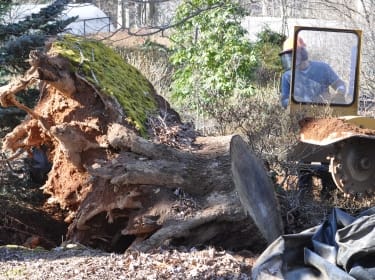Maryland Tree Removal: Insights from the Professionals
Tree removal may seem straightforward, but it’s a complex process that involves expertise, heavy equipment, and an experienced team. Whether a tree is dead, declining, or simply in the way of your home’s landscaping goals, removal should always be handled with care by professionals. Alice from Ed’s Tree Service walks us through what goes into a safe, efficient tree removal in Maryland—from the initial decision to the final cleanup.
If you can’t watch the video above, here’s what Alice has to say:
Q: How do you know if a tree needs to be removed vs. trimmed?
If the tree is dead, it definitely needs to be removed. Or if it’s in decline, it needs to be removed. Sometimes people choose to remove live trees—maybe it’s too close to their house or foundation, or they want to open up their yard. I go off the customer’s needs unless I’m telling them it has to be removed for safety reasons.
Q: What is the tree removal process from start to finish?
Once we get there, we usually use a Bobcat to haul the wood to the street. We roll it over large plastic mats, about 10 by 5 feet, to avoid lawn damage. We climb the tree, and every branch we cut is lowered down by rope. The ground crew drags the limbs to the street. Then we start logging the tree from the top down in sections.
Q: What tools and equipment are used during a tree removal?
The climbers wear saddles, ropes to secure themselves, and lowering lines so groundmen can gently lower branches. Everyone wears safety gear—hard hats, eye protection, earmuffs, vests, gloves, and chaps when cutting on the ground.
Q: What are the signs that a tree is a safety hazard and needs to be removed?
If a tree is dead or has large cavities at the base, it’s a hazard. Sometimes we remove trees leaning over houses or decks because homeowners feel uncomfortable. All the wood and branches are chipped and sent to a green landfill—those chips become the mulch you buy at Home Depot.
Q: How do you handle tree removal in tight spaces or near structures?
If there’s no landing zone to lower branches safely, we’ll use a crane to boom out sections to the street. Every yard is different, but sometimes removing one large tree opens up the space for more flowering or decorative trees.
Why Trees Get Removed—Even If They’re Alive
While dead or declining trees are obvious candidates for removal, homeowners sometimes choose to remove healthy trees for other reasons:
- Proximity to the house or foundation
- Desire to open up yard space or improve sunlight
- Landscape redesigns with different tree species
- Concern about leaning trees over decks, roofs, or play areas
At Ed’s Tree Service, we listen to our customers’ goals and advise removal only when it’s necessary for safety or long-term property health.
Safe, Professional Tree Removal in Maryland
A safe tree removal requires a well-trained crew and the right tools:
- Plastic lawn mats to protect your grass
- Climbers with saddles, ropes, and lowering lines
- Bobcats for hauling heavy wood
- Cranes for tight spaces
- Protective safety equipment for every crew member
From the top of the tree to the last wood chip, each step is managed to avoid damage and maintain your property’s appearance. All our wood and chips go to a green landfill for repurposing into mulch so nothing goes to waste.
Need a Tree Removed? Trust a Maryland Tree Expert
If you’re dealing with a dead or declining tree, or want to make room for a new landscape vision, contact a professional Maryland tree removal company like Ed’s Tree Service. We offer free estimates, honest recommendations, and top-notch service that puts safety first.





